3D-Basin Modeling of the Changling Depression, NE China: Exploring Petroleum Evolution in Deep Tight Sandstone Reservoirs
Abstract
:1. Introduction
2. Geological Evolution
- Basement thermal uplift stage: the paleo-continent split up at the end of the Triassic and began to disassemble inside the continent during the Jurassic. During this geological period, the Eurasian Plate drifted southeastward while the Pacific Plate began to expand and resulted in plate subduction. This sequence triggered mantle upwelling, and the upper mantle and crust extended to form the rift. Mantle materials erupted through the fissure and formed the widespread pyroclastic reservoir [43,44].
- Rifting stage: the previously accumulated heat energy suddenly released and created a crack in the crust. Then, the faulted period began and the Songliao Basin gained the embryonic form of a graben or half-graben morphology. In the meantime, volcanic eruptions, magmatic intrusions and regional metamorphic events occurred through deep fractures. The Upper Jurassic Huoshiling Formation (J3h) and the Lower Cretaceous Shahezi Formation (K1sh) and Yingcheng Formation (K1y) exhibited sedimentary systems such as alluvial fans, flooding plains, pluvial deltas, and fan deltas (Figure 2). A series of NNE faults formed during the deposition of the J3h stratum and caused massive volcanic eruption with andesite and basalt extrusions. During the deposition of K1sh, construction of the Changling depression was controlled by boundary faults. A set of dark mudstone with coal seams formed the lacustrine source rocks of the K1y and K1sh strata. The rising rift, intense fault activity and rapid tectonic subsidence resulted in the deepening and expansion of the basin. The isolated basins began to connect during the transgressive period. The main stratum deposited was K1d, and the sedimentary environment was similar to that during the early rifting stage [45,46,47].
- Depression stage: the basin entered a depression stage when the crust achieved differential settlement. Volcanic activity dissipated and the depression achieved a uniform sedimentary setting. Widespread lakes appeared in the depression alongside a range of depositional systems. A full combination of spatial-deposition systems developed from the land to the lacustrine area, including alluvial fans, flooding plains, shallow lacustrine deltas, and deep water turbidite. The strata included the Quantou Formation (K1q), Qingshankou Formation (K2qn), Yaojia Formation (K2y) and Nenjiang Formation (K2n). During this stage, the paleo heat flow frequently changed because of fault activity [41].
- Tectonic inversion stage: during the last phase of the basin evolution, the Japan Sea expanded and the basin continued to exhibit extrusion. Tectonic inversion occurred when the strata were lifted and folded. The remaining lacustrine area shrank but the overall shape of the depression remained similar. The strata included the Upper Cretaceous Sifangtai Formation (K2s) and Mingshui Formation (K2m), with the depositional systems including shallow lacustrine, alluvial fan and flooding plain facies. After the Cretaceous, the lakes almost disappeared and the strata uplifted and descended in slow motion. Alluvial and diluvial deposits have been discovered in this sequence [13,41,42].
3. Construction of the Basin Model
3.1. Input Data
3.1.1. Lithology and Petroleum System Elements
3.1.2. Source Rock Properties
3.1.3. Kinetic Models
3.1.4. Fault Properties
3.1.5. Erosion Events
- Tectonic inversion occurred at the end of K1y deposition (128.8~124 Ma). The basin was regionally uplifted and experienced differing degrees of erosion. The average erosion thickness was 417.5 m [46].
- During the end of K2n deposition (74.6~73 Ma), the strata uplifted because of intense extrusion stress and underwent continuous denudation to a thickness of approximately 205 m.
- During the late Mingshui period (66.2~23.03 Ma), the Changling Depression underwent basin shrinkage, tectonic inversion and regional uplift [66]. The average denudation thickness was 342.5 m. The main uplift and erosion center is in the Fulongquan region around Well F10.
3.1.6. Boundary Conditions
3.1.7. Petrophysical Settings
4. Results
4.1. Calibration of the Model
4.2. Source Rock Maturation, Petroleum Generation and Expulsion
4.3. Hydrocabon Accumulation in the Main Reservoir: Denglouku Formation
5. Discussion
5.1. Definition of Key Hydrocarbon-Accumulation Moments
5.1.1. Haerjin Structure: Well CS1
5.1.2. Shuangtuozi Structure: Well TS1
5.1.3. Dalaoyefu Structure: Well L14
5.1.4. Fulongquan Structure: Well F3
5.2. Migration and Accumulation Rules in the Changling Depression
6. Conclusions
Author Contributions
Funding
Conflicts of Interest
References
- Yang, G.; Zhao, Z.Y.; Shao, M.L. Formation of carbon dioxide and hydrocarbon gas reservoirs in the Changling fault depression, Songliao Basin. Pet. Explor. Dev. 2011, 38, 52–58. [Google Scholar]
- Dong, T.; He, S.; Yin, S.Y.; Wang, D.X.; Hou, Y.G.; Guo, J.G. Geochemical characterization of source rocks and crude oils in the Upper Cretaceous Qingshankou Formation, Changling Sag, southern Songliao Basin. Mar. Pet. Geol. 2015, 64, 173–188. [Google Scholar] [CrossRef]
- Dong, T.; He, S.; Wang, D.X.; Hou, Y.G. Hydrocarbon migration and accumulation in the Upper Cretaceous Qingshankou Formation, Changling Sag, southern Songliao Basin: Insights from integrated analyses of fluid inclusion, oil source correlation and basin modelling. J. Asian Earth Sci. 2014, 90, 77–87. [Google Scholar] [CrossRef]
- Xu, J.J.; Liu, Z.J.; Bechtel, A.; Meng, Q.T.; Sun, P.C.; Jia, J.L.; Cheng, L.J.; Song, Y. Basin evolution and oil shale deposition during Upper Cretaceous in the Songliao Basin (NE China): Implications from sequence stratigraphy and geochemistry. Int. J. Coal Geol. 2015, 149, 9–23. [Google Scholar] [CrossRef]
- Gao, F.L.; Song, Y.; Li, Z.; Xiong, F.Y.; Chen, L.; Zhang, Y.H.; Liang, Z.K.; Zhang, X.X.; Chen, Z.Y.; Joachim, M. Lithofacies and reservoir characteristics of the Lower Cretaceous continental Shahezi Shale in the Changling Fault Depression of Songliao Basin, NE China. Mar. Pet. Geol. 2018, 98, 401–421. [Google Scholar] [CrossRef]
- Li, H.; Lu, J.L.; Li, R.L.; Wang, B.H.; Xu, W.; Zuo, Z.X.; Wang, M.; Liu, Y.Z. Generation Paleoenvironment and Its Controlling Factors of Lower Cretaceous Lacustrine Hydrocarbon Source Rocks in Changling Depression, South Songliao Basin. Earth Sci. 2017, 42, 1774–1786. (In Chinese) [Google Scholar]
- Yuan, J.; Wang, W.; Zhu, J.F.; Chen, X.X.; Zhao, H.H. Research on provenance and sedimentary facies of Yingcheng Formation in Lower Cretaceous in Longfengshan Subsag, Changling Fault Depression, Songliao Basin. Nat. Gas Geosci. 2017, 28, 93–105. (In Chinese) [Google Scholar]
- Zhang, P.H.; Lee, Y.I.; Zhang, J.L. Diagenesis of tight-gas sandstones in the Lower Cretaceous Denglouku Formation, Songliao Basin, NE China: Implications for reservoir quality. J. Pet. Geol. 2015, 38, 99–114. [Google Scholar] [CrossRef]
- Li, Y.; Chang, X.C.; Yin, W.; Sun, T.T.; Song, T.T. Quantitative impact of diagenesis on reservoir quality of the Triassic Chang 6 tight oil sandstones, Zhenjing area, Ordos Basin, China. Mar. Pet. Geol. 2017, 86, 1014–1028. [Google Scholar] [CrossRef]
- Shi, B.B.; Chang, X.C.; Yin, W.; Li, Y.; Mao, L.X. Quantitative evaluation model for tight sandstone reservoirs based on statistical methods—A case study of the Triassic Chang 8 tight sandstones, Zhenjing area, Ordos Basin, China. J. Pet. Sci. Eng. 2019, 173, 601–616. [Google Scholar] [CrossRef]
- Li, Y.; Chang, X.C.; Yin, W.; Wang, G.W.; Zhang, J.L.; Shi, B.B.; Zhang, J.H.; Mao, L.X. Quantitative identification of diagenetic facies and controls on reservoir quality for tight sandstones: A case study of the Triassic Chang 9 oil layer, Zhenjing area, Ordos Basin. Mar. Pet. Geol. 2019, 102, 680–694. [Google Scholar] [CrossRef]
- Liu, M.J.; Liu, Z.; Wu, Y.W.; Zhu, W.Q.; Wang, P. Differences in formation process of tight sandstone gas reservoirs in different substructures in Changling Fault Depression, Songliao Basin, NE China. Pet. Explor. Dev. 2017, 44, 257–264. [Google Scholar] [CrossRef]
- Chen, J.; Zhang, Q.L.; Wang, L.S.; Xie, G.A.; Xu, S.Y.; Bi, S.P.; Ge, R.F. Tectonic transformation of Changling Fault Depression in the Southern Songliao Basin and its significance of hydrocarbon accumulation. Acta Geol. Sin. 2008, 82, 1027–1035. (In Chinese) [Google Scholar]
- Zhu, Y.H.; Wang, J. Resource potential in the deep of the Shiwu Fault Depression and the Changling Sag, the Songliao Basin. Pet. Geol. Exp. 2003, 25, 149–152. (In Chinese) [Google Scholar]
- Zhu, J.H. Research on the Source Rock Evaluation and Gas Dynamic Reservoir Forming Rule in Changling Fault Depression. Ph.D. Thesis, Chengdu University of Technology, Chengdu, China, 2015. [Google Scholar]
- Welte, D.H.; Yalcin, M.N. Basin Modeling—A New Comprehensive Method in Petroleum Geology. Org. Geochem. 1988, 13, 141–151. [Google Scholar] [CrossRef]
- Welte, D.H.; Yukler, M.A. Petroleum Origin and Accumulation in Basin Evolution—A Quantitative Model. AAPG Bull. 1981, 65, 1387–1396. [Google Scholar]
- Hadad, Y.T.; Hakimi, M.H.; Abdullah, W.H.; Makeen, Y.M. Basin modeling of the Late Miocene Zeit source rock in the Sudanese portion of Red Sea Basin: Implication for hydrocarbon generation and expulsion history. Mar. Pet. Geol. 2017, 84, 311–322. [Google Scholar] [CrossRef]
- Radkovets, N.; Kosakowski, P.; Rauball, J.; Zakrzewski, A. Burial and Thermal History Modelling of the Ediacaran Succession in Western and Sw Ukraine and Moldova. J. Pet. Geol. 2018, 41, 85–106. [Google Scholar] [CrossRef]
- Hlaiem, A.; Biju-Duval, B.; Vially, R.; Laatar, E.; M’Rabet, A. Burial and thermal history modelling of the Gafsa-Metlaoui intracontinental Basin (southern Tunisia): Implications for petroleum exploration. J. Pet. Geol. 1997, 20, 403–425. [Google Scholar] [CrossRef]
- Premarathne, U.; Suzuki, N.; Ratnayake, N.; Kularathne, C. Burial and Thermal History Modelling of the Mannar Basin, Offshore Sri Lanka. J. Pet. Geol. 2016, 39, 193–213. [Google Scholar] [CrossRef]
- Galushkin, Y.; Eloghbi, S.; Sak, M. Burial and Thermal History Modelling of the Murzuq and Ghadames Basins (Libya) Using the Galo Computer Programme. J. Pet. Geol. 2014, 37, 71–93. [Google Scholar] [CrossRef]
- Chang, X.C.; Wang, T.G.; Li, Q.M.; Ou, G.X. Charging of Ordovician Reservoirs in the Halahatang Depression (Tarim Basin, Nw China) Determined by Oil Geochemistry. J. Pet. Geol. 2013, 36, 383–398. [Google Scholar]
- Baniasad, A.; Rabbani, A.; Sachse, V.F.; Littke, R.; Moallemi, S.A.; Soleimany, B. 2D basin modeling study of the Binak Trough, northwestern Persian Gulf, Iran. Mar. Pet. Geol. 2016, 77, 882–897. [Google Scholar] [CrossRef]
- Brandes, C.; Astorga, A.; Littke, R.; Winsemann, J. Basin modelling of the Limon Back-arc Basin (Costa Rica): Burial history and temperature evolution of an island arc-related basin-system. Basin Res. 2008, 20, 119–142. [Google Scholar] [CrossRef]
- Lv, D.W.; Chen, J.T.; Li, Z.X.; Zheng, G.Q.; Song, C.Y.; Liu, H.Y.; Meng, Y.R.; Wang, D.D. Controlling Factors, Accumulation Model and Target Zone Prediction of the Coal-bed Methane in the Huanghebei Coalfield, North China. Resour. Geol. 2014, 64, 332–345. [Google Scholar] [CrossRef] [Green Version]
- Bruns, B.; Littke, R.; Gasparik, M.; van Wees, J.D.; Nelskamp, S. Thermal evolution and shale gas potential estimation of the Wealden and Posidonia Shale in NW-Germany and the Netherlands: A 3D basin modelling study. Basin Res. 2016, 28, 2–33. [Google Scholar] [CrossRef]
- Mohsenian, E.; Fathi-Mobarakabad, A.; Sachsenhofer, R.F.; Asadi-Eskandar, A. 3d Basin Modelling in the Central Persian Gulf, Offshore Iran. J. Pet. Geol. 2014, 37, 55–70. [Google Scholar] [CrossRef]
- Pang, Y.M.; Zhang, X.H.; Guo, X.W.; Xiao, G.L.; Han, Z.Z. Basin modeling in the initial stage of exploration: A case study from the North Subbasin of the South Yellow Sea Basin. Acta Oceanol. Sin. 2017, 36, 65–78. [Google Scholar] [CrossRef]
- Hantschel, T.; Kauerauf, A.I. Fundamentals of Basin and Petroleum Systems Modeling; Springer: Berlin/Heidelberg, Germany, 2009. [Google Scholar]
- Sachse, V.F.; Anka, Z.; Littke, R.; Rodriguez, J.F.; Horsfield, B.; di Primio, R. Burial, Temperature and Maturation History of the Austral and Western Malvinas Basins, Southern Argentina, Based on 3d Basin Modelling. J. Pet. Geol. 2016, 39, 169–191. [Google Scholar] [CrossRef]
- Arfai, J.; Lutz, R. 3D basin and petroleum system modelling of the NW German North Sea (Entenschnabel). In Petroleum Geology of Nw Europe: 50 Years of Learning—Proceedings of the 8th Petroleum Geology Conference; Bowman, M., Levell, B., Eds.; Geological Society: London, UK, 2018; pp. 67–86. [Google Scholar]
- Olaru, R.; Krezsek, C.; Rainer, T.M.; Ungureanu, C.; Turi, V.; Ionescu, G.; Tari, G. 3D Basin Modelling of Oligocene-Miocene Maikop Source Rocks Offshore Romania and in the Western Black SEA. J. Pet. Geol. 2018, 41, 351–365. [Google Scholar] [CrossRef]
- Butt, A.J.; Gould, K. 3D source-rock modelling in frontier basins: A case study from the Zambezi Delta Depression. Pet. Geosci. 2018, 24, 277–286. [Google Scholar] [CrossRef]
- Zhang, J.L.; Guo, J.Q.; Liu, J.S.; Shen, W.L.; Li, N.; Xu, G.C. 3D-Basin Modelling of the Lishui Sag: Research of Hydrocarbon Potential, Petroleum Generation and Migration. Energies 2019, 12, 650. [Google Scholar] [CrossRef]
- Schneider, F.; Wolf, S.; Faille, I.; Pot, D. A 3D basin model for hydrocarbon potential evaluation: Application to Congo offshore. Oil Gas Sci. Technol. 2000, 55, 3–13. [Google Scholar] [CrossRef]
- McLimans, R.K. The application of fluid inclusions to migration of oil and diagenesis in petroleum reservoirs. Appl. Geochem. 1987, 2, 585–603. [Google Scholar] [CrossRef]
- Parnell, J. Potential of palaeofluid analysis for understanding oil charge history. Geofluids 2010, 10, 73–82. [Google Scholar]
- Bhullar, A.G.; Karlsen, D.A.; Backer-Owe, K.; Seland, R.T.; Le Tran, K. Dating reservoir filling—A case history from the North Sea. Mar. Pet. Geol. 1999, 16, 581–603. [Google Scholar] [CrossRef]
- Wang, P.J.; Chen, C.Y.; Zhang, Y.; Gao, Y.F.; Qu, X.J.; Yi, J. Characteristics of volcanic reservoirs and distribution rules of effective reservoirs in the Changling fault depression, Songliao Basin. Nat. Gas Ind. B 2015, 2, 440–448. [Google Scholar] [CrossRef] [Green Version]
- Wang, J.Q.; Yang, G.; Xue, L.F.; Zhang, J.W.; Bai, Y.; Li, W.B. Tectonic evolution of the Changling fault basin and its relationship to oil and gas accumulation. Min. Sci. Technol. (China) 2011, 21, 427–432. [Google Scholar] [CrossRef]
- Feng, Z.Q.; Jia, C.Z.; Xie, X.N.; Zhang, S.; Feng, Z.H.; Cross, T.A. Tectonostratigraphic units and stratigraphic sequences of the nonmarine Songliao basin, northeast China. Basin Res. 2010, 22, 79–95. [Google Scholar]
- Wei, H.H.; Liu, J.L.; Meng, Q.R. Structural and sedimentary evolution of the southern Songliao Basin, northeast China, and implications for hydrocarbon prospectivity. Am. Assoc. Pet. Geol. Bull. 2010, 94, 533–566. [Google Scholar] [CrossRef]
- Chang, X.C.; Wang, Y.; Shi, B.B.; Xu, Y.D. Charging of Carboniferous volcanic reservoirs in the eastern Chepaizi uplift, Junggar Basin (NW China) constrained by oil geochemistry and fluid inclusion. AAPG Bull. 2018. [Google Scholar] [CrossRef]
- Jiang, H.J. Research on Stratigraphic Characteristics of Deep Formation in Changling Fault Depression. Master’s Thesis, Northeast Petroleum University, Daqing, China, 2011. [Google Scholar]
- Wang, P.J.; Mattern, F.; Didenko, N.A.; Zhu, D.F.; Singer, B.; Sun, X.M. Tectonics and cycle system of the Cretaceous Songliao Basin: An inverted active continental margin basin. Earth-Sci. Rev. 2016, 159, 82–102. [Google Scholar] [CrossRef] [Green Version]
- Wang, P.J.; Xie, X.A.; Mattem, F.; Ren, Y.G.; Zhu, D.F.; Sun, X.M. The Cretaceous Songliao basin: Volcanogenic succession, sedimentary sequence and tectonic evolution, NE China. Acta Geol. Sin.-Eng. Ed. 2007, 81, 1002–1011. [Google Scholar]
- Lin, C.S.; Li, S.T.; Zhang, Q.M.; Zhang, Y.M. Lithospheric stretching, subsidence and thermal history modeling: Application to Yinggehai, Qiongdongnan and Songliao Basins in East China. J. China Univ. Geosci. 1997, 8, 83–89. [Google Scholar]
- Zhang, S.Q.; Ren, Y.G. The study of base level changes of the Songliao Basin in Mesozoic. J. Chang. Univ. (Earth Sci. Ed.) 2003, 25, 1–5. (In Chinese) [Google Scholar]
- Hantschel, T.; Kauerauf, A.I.; Wygrala, B. Finite element analysis and ray tracing modeling of petroleum migration. Mar. Pet. Geol. 2000, 17, 815–820. [Google Scholar] [CrossRef]
- Ge, R.F.; Zhang, Q.L.; Xu, S.Y.; Wang, L.S.; Xie, G.A.; Chen, J.; Wang, X.Y. Structure evolution and its kinetic setting of Changling fault depression in Songliao basin. J. Geol. 2009, 33, 346–358. (In Chinese) [Google Scholar]
- Ma, C.C.; Wang, J.Q.; Sun, J.; Zhang, J.W. Tectonic evolution and oil-gas reservoir forming period of Changling fault depression. Glob. Geol. 2013, 32, 305–316. (In Chinese) [Google Scholar]
- Yuan, W.; Xu, X.H.; Lu, J.L.; Yang, Z.Y.; Wang, B.H.; Zhu, J.F. Zircon SHRIMP dating and Hf isotope compositions of Late Mesozoic volcanic rocks from Changling fault depression, Songliao Basin, and their geological implications. Geol. Bull. China 2014, 33, 1473–1481. (In Chinese) [Google Scholar]
- Wu, Q.; Pu, R.H.; Han, M.Q.; Cao, H.H.; Li, Q. Zircon LA-ICP-MS U-Pb dating for the volcanic rocks in Changling Depression, and its geological implication. J. Miner. Pet. 2010, 30, 111–119. (In Chinese) [Google Scholar]
- Duran, E.R.; di Primio, R.; Anka, Z.; Stoddart, D.; Horsfield, B. 3D-basin modelling of the Hammerfest Basin (southwestern Barents Sea): A quantitative assessment of petroleum generation, migration and leakage. Mar. Pet. Geol. 2013, 45, 281–303. [Google Scholar] [CrossRef]
- Huang, W.B. The evaluation of deep source rocks and prediction of favorable areas in the mid-west fault depression, Songliao Southern Basin. Ph.D. Thesis, Northeast Petroleum University, Daqing, China, 2010. [Google Scholar]
- Kong, P.F.; Zhang, M. Geochemical research in Huoshiling Formation of source rocks in Dongling fault Depression of Changling area. J. Yangtze Univ. (Nat. Sci. Ed.) 2012, 9, 33–37. (In Chinese) [Google Scholar]
- Zhou, Z.M.; Wang, B.H.; Zhu, T.X.; Song, Z.X. Source rock features and exploration potential of Huoshiling Formation, Changling Fault Depression. Pet. Geol. Exp. 2011, 33, 613–616. (In Chinese) [Google Scholar]
- Lafargue, E.; Marquis, F.; Pillot, D. Rock-Eval 6 applications in hydrocarbon exploration, production, and soil contamination studies. Oil Gas Sci. Technol. 1998, 53, 421–437. [Google Scholar] [CrossRef]
- Behar, F.; Beaumont, V.; Penteado, H.L.D. Rock-Eval 6 technology: Performances and developments. Oil Gas Sci. Technol. Rev. IFP 2001, 56, 111–134. [Google Scholar] [CrossRef]
- Tissot, B.P.; Welte, D.H. Petroleum Formation and Occurrence; Springer: Berlin, Germany, 1978. [Google Scholar]
- Baskin, D.K. Atomic H/C ratio of kerogen as an estimate of thermal maturity and organic matter conversion. AAPG Bull. 1997, 81, 1437–1450. [Google Scholar]
- Espitalie, J. Use of Tmax as a maturation index for different types of organic matter: Comparison with vitrinite reflectance. In Thermal Modelling in Sedimentary Basins; Institut français du pétrole, Centre national de la recherche scientifique: Paris, France, 1986; pp. 475–496. [Google Scholar]
- Wang, Z.; Zhu, W.; Chen, C.; Fu, X. Basement Lithology and Distribution of Lishui-Jiaojiang Cenozoic Sag in East China Sea. J. Tongji Univ. Nat. Sci. 2014, 42, 636–644. [Google Scholar]
- Sun, D. The Prediction of Source Rocks Distribution and the Research of Hydrocarbon Generation Potential of Changling Fault Depression. Master’s Thesis, Northeast Petroleum University, Daqing, China, 2014. [Google Scholar]
- Wang, J.Q. The Research on Oil-Gas Reservoir Model and Distribution in the Changling Fault Depression. Master’s Thesis, Jilin University, Changchun, China, 2009. [Google Scholar]
- Tang, H.; Zhao, X.; Shao, M.; Sun, X.; Zhang, Y.; Cryton, P. Reservoir origin and characterization of gas pools in intrusive rocks of the Yingcheng Formation, Songliao Basin, NE China. Mar. Pet. Geol. 2017, 84, 148–159. [Google Scholar] [CrossRef]
- Lewan, M.D.; Ruble, T.E. Comparison of petroleum generation kinetics by isothermal hydrous and nonisothermal open-system pyrolysis. Org. Geochem. 2002, 33, 1457–1475. [Google Scholar] [CrossRef]
- Burnham, A.K. A Simple Kinetic Model of Petroleum Formation and Cracking; Lawrence Livermore National Laboratory: Livermore, CA, USA, 1989.
- Xue, H.Q.; Li, S.Y.; Wang, H.Y.; Zheng, D.W.; Fang, C.H. Pyrolysis kinetics of oil shale from Northern Songliao Basin in China. Oil Shale 2010, 27, 5–16. [Google Scholar]
- Zan, L.; Zhang, Z.H.; Huang, J.P.; He, X.; Feng, R.J.; Wu, Y.Y.; Fei, J.J.; Li, W.H. Geochemical characteristics of natural fas and its origin in Changling Fault Depression of Songliao Basin, Northeastern China. Nat. Gas Geosci. 2010, 21, 331–337. (In Chinese) [Google Scholar]
- Cao, H.R.; Zou, Y.R.; Lei, Y.; Xi, D.P.; Wan, X.Q.; Peng, P.A. Shale oil assessment for the Songliao Basin, Northeastern China, using oil generation–sorption method. Energy Fuels 2017, 31, 4826–4842. [Google Scholar] [CrossRef]
- Xie, L.J.; Sun, Y.G.; Jiang, A.Z.; Wang, F.Y.; Chen, J.P. Experimental study on the gas generation processes of lacustrine and marine shales in North China: Source implications for shale gas. Mar. Pet. Geol. 2015, 67, 204–216. [Google Scholar] [CrossRef]
- Wang, M.; Lu, S.F.; Xue, H.T. Kinetic simulation of hydrocarbon generation from lacustrine type I kerogen from the Songliao Basin: Model comparison and geological application. Mar. Pet. Geol. 2011, 28, 1714–1726. [Google Scholar]
- Pepper, A.S.; Corvi, P.J. Simple kinetic models of petroleum formation. Part III: Modelling an open system. Mar. Pet. Geol. 1995, 12, 417–452. [Google Scholar] [CrossRef]
- Wang, M.; Dong, Q.; Lu, S.F.; Tian, S.S.; Chen, G.H.; Sun, Y.F. Pyrolysis products characteristics and kinetic analysis of coal from Shahezi Formation of Songliao Basin under the TG-MS experiment. J. China Coal Soc. 2012, 37, 1150–1155. (In Chinese) [Google Scholar]
- Li, M.; Zhao, Y.M.; Liu, X.; Zhang, Y.M.; Wang, Y.S. Distribution of petroleum enriched areas, Changling Sag, southern Songliao Basin. Pet. Explor. Dev. 2009, 36, 413–418. [Google Scholar]
- Chen, J. Tectonic Transformation of Changling Fault Depression and Significance of Hydrocarbon Accumulation in Southern Songliao Basin. Master’s Thesis, Nanjing University, Nanjing, China, 2010. [Google Scholar]
- Xiang, C.F.; Feng, Z.Q.; Pang, X.Q.; Wu, H.Y.; Li, J.H. Late stage thermal history of the Songliao Basinband its tectonic implications: Evidence from apatite fission track (AFT) analyses. Sci. China Ser. D-Earth Sci. 2007, 50, 1479–1487. [Google Scholar] [CrossRef]
- Wang, C.S.; Feng, Z.Q.; Zhang, L.M.; Huang, Y.J.; Cao, K.; Wang, P.J.; Zhao, B. Cretaceous paleogeography and paleoclimate and the setting of SKI borehole sites in Songliao Basin, northeast China. Palaeogeogr. Palaeoclimatol. Palaeoecol. 2013, 385, 17–30. [Google Scholar] [CrossRef]
- Yalçin, M.N.; Littke, R.; Sachsenhofer, R.F. Thermal History of Sedimentary Basins. In Petroleum and Basin Evolution; Welte, D.H., Horsfield, B., Baker, D.R., Eds.; Springer: Berlin/Heidelberg, Germany; New York, NY, USA, 1997; pp. 71–161. [Google Scholar]
- Wygrala, B.P. Integrated Study of an Oil Field in the Southern Po Basin, Northern Italy. Ph.D. Thesis, University of Cologne, Cologne, Germany, 1989. [Google Scholar]
- Li, Z.A. Evolutionary features of mantle heat flux in Songliao Basin. Geotecton. Metallog. 1995, 19, 104–112. (In Chinese) [Google Scholar]
- He, S.; Tao, Y.C.; Jiang, P. Study on geothermal history in swell area of Southeast Songliao Basin by using several paleogeothermometers. Earth Sci.-J. China Univ. Geosci. 1995, 20, 328–334. (In Chinese) [Google Scholar]
- Ren, Z.L.; Xiao, D.M.; CHI, Y.L. Restoration of the palaeogeotherm in Songliao Basin. Pet. Geol. Oilfield Dev. Daqing 2001, 20, 13–14, 55. (In Chinese) [Google Scholar]
- Athy, L.F. Density, porosity, and compaction of sedimentary rocks. Bull. Am. Assoc. Pet. Geol. 1930, 1, 1–24. [Google Scholar]
- Larter, S. Chemical-Models of Vitrinite Reflectance Evolution. Geol. Rundsch. 1989, 78, 349–359. [Google Scholar] [CrossRef]
- Lerche, I.; Yarzab, R.F.; Kendall, C.G.S.C. Determination of Paleoheat Flux from Vitrinite Reflectance Data. AAPG Bull. 1984, 68, 1704–1717. [Google Scholar]
- Sweeney, J.J.; Burnham, A.K. Evaluation of a Simple-Model of Vitrinite Reflectance Based on Chemical-Kinetics. AAPG Bull. 1990, 74, 1559–1570. [Google Scholar]
- Burnham, A.K.; Sweeney, J.J. A chemical kinetic model of vitrinite maturation and reflectance. Geochim. Cosmochim. Acta 1989, 53, 2649–2657. [Google Scholar] [CrossRef]
- Guo, X.W.; Liu, K.Y.; He, S.; Song, G.Q.; Wang, Y.S.; Hao, X.F.; Wang, B.J. Petroleum generation and charge history of the northern Dongying Depression, Bohai Bay Basin, China: Insight from integrated fluid inclusion analysis and basin modelling. Mar. Pet. Geol. 2012, 32, 21–35. [Google Scholar] [CrossRef]
- Oxtoby, N.H. Comments on: Assessing the maturity of oil trapped in fluid inclusions using molecular geochemistry data and visually-determined fluorescence colours. Appl. Geochem. 2002, 17, 1371–1374. [Google Scholar] [CrossRef]
- Stasiuk, L.D.; Snowdon, L.R. Fluorescence micro-spectrometry of synthetic and natural hydrocarbon fluid inclusions: Crude oil chemistry, density and application to petroleum migration. Appl. Geochem. 1997, 12, 229–241. [Google Scholar] [CrossRef]
- Zhang, J.L.; Chang, X.C.; Liu, B.J.; Mao, F.M. Fluid history analysis and formation mechanism of the Yancheng petroleum reservoir. Acta Geol. Sin. 2002, 76. (In Chinese) [Google Scholar]
- Meng, F.Y. Accumulation conditions and models of natural gas in Denglouku Formation, Changling Rift. Ph.D. Thesis, China University of Petroleum, Beijing, China, 2009. [Google Scholar]

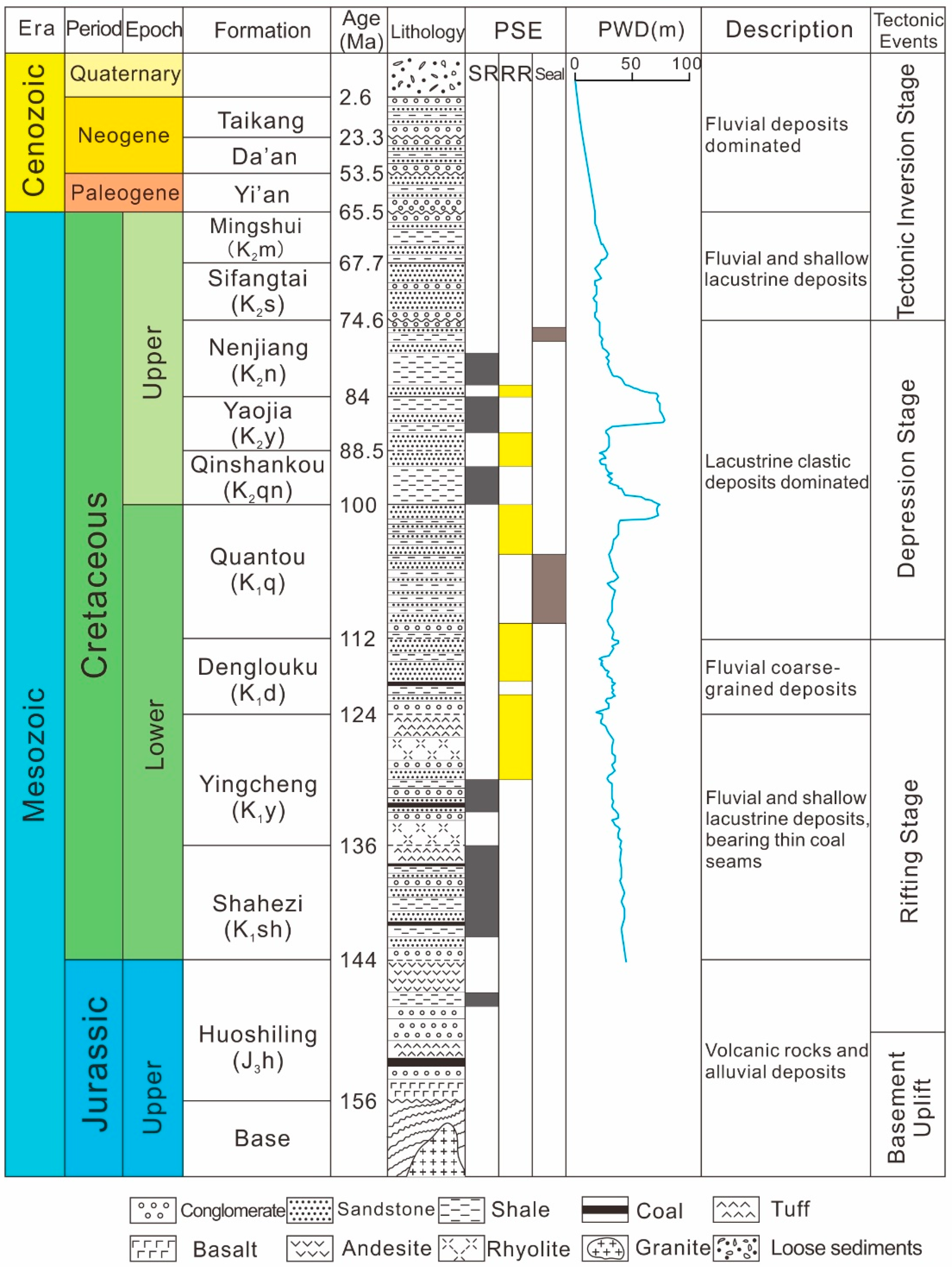

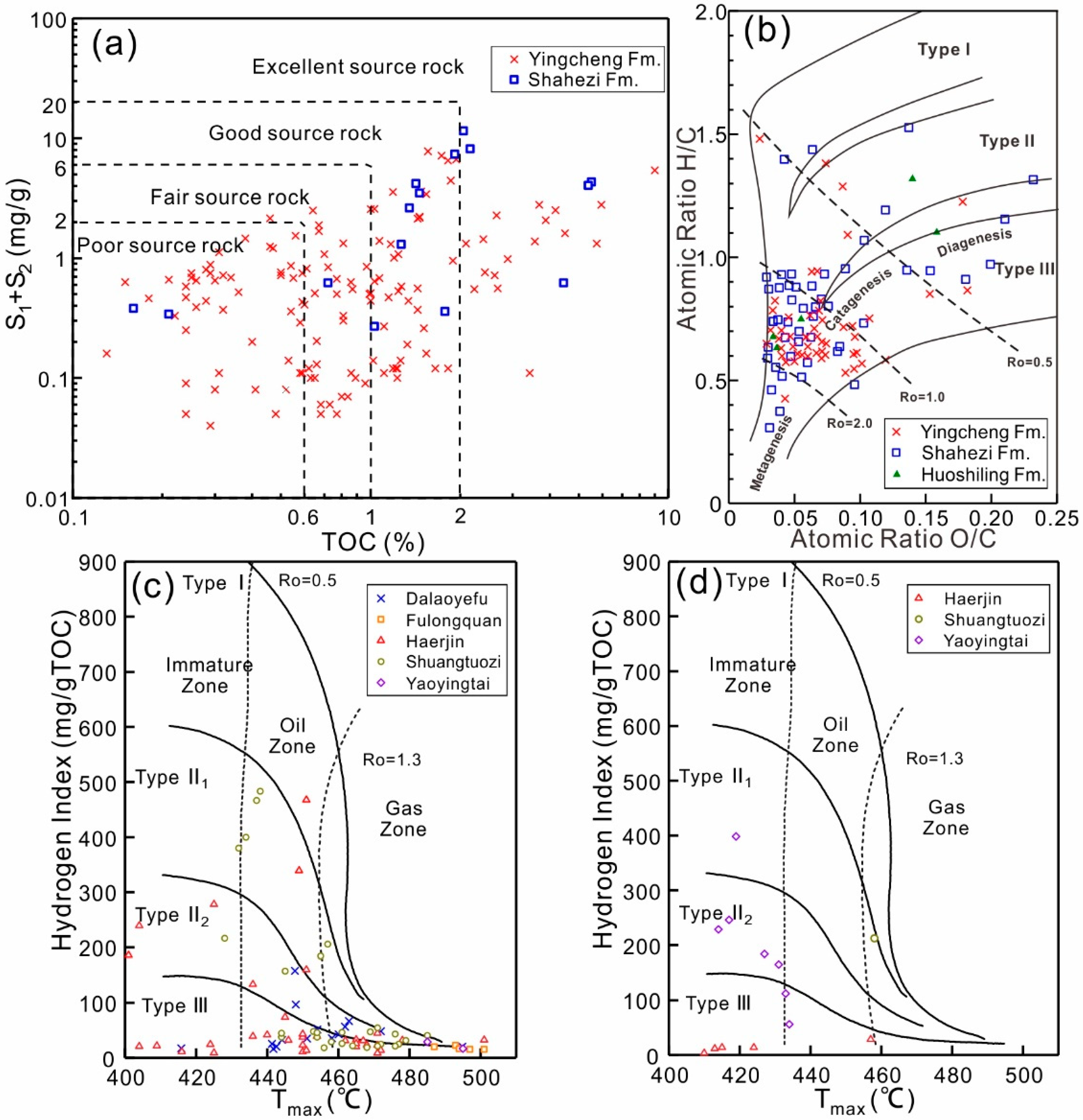

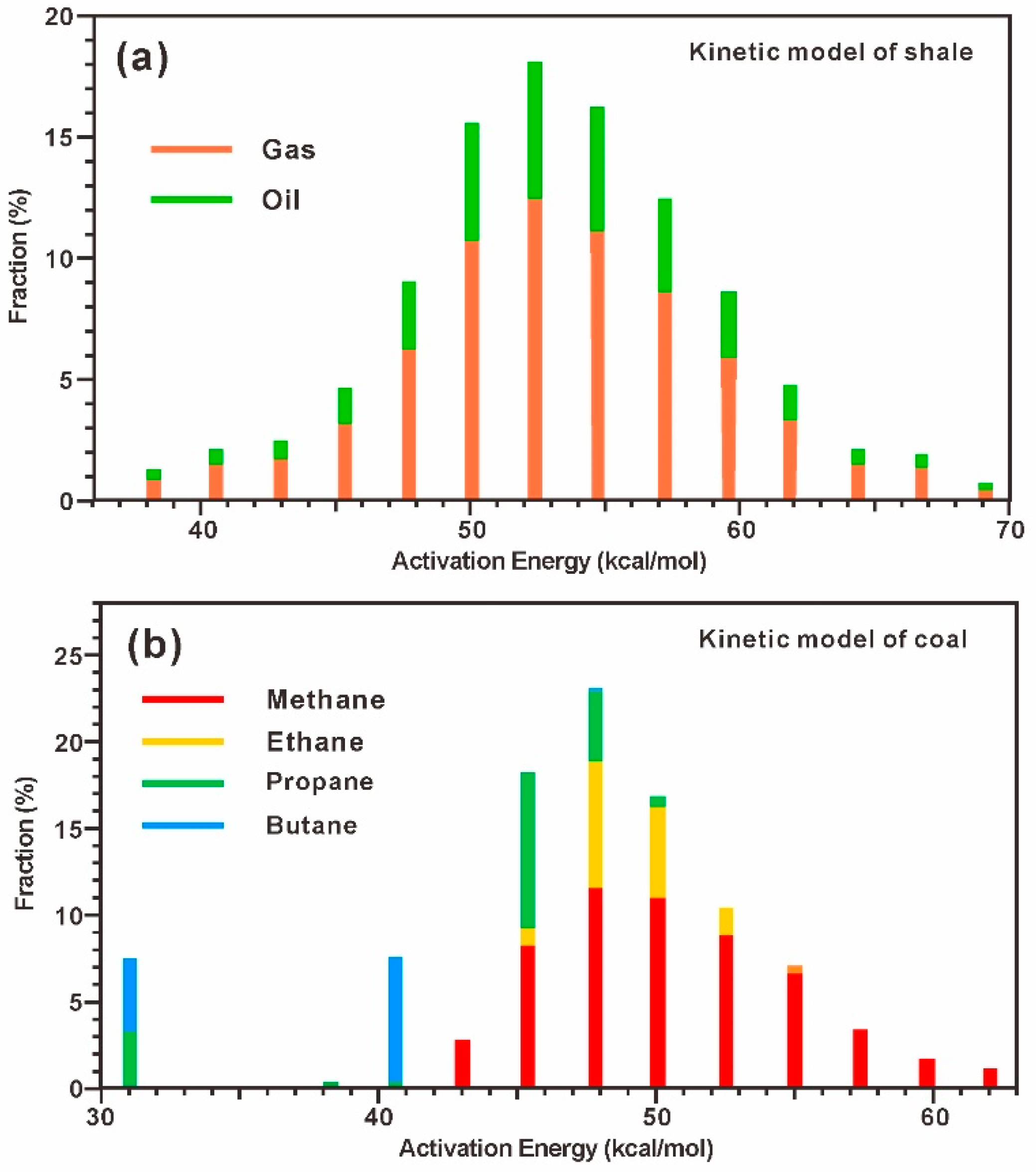

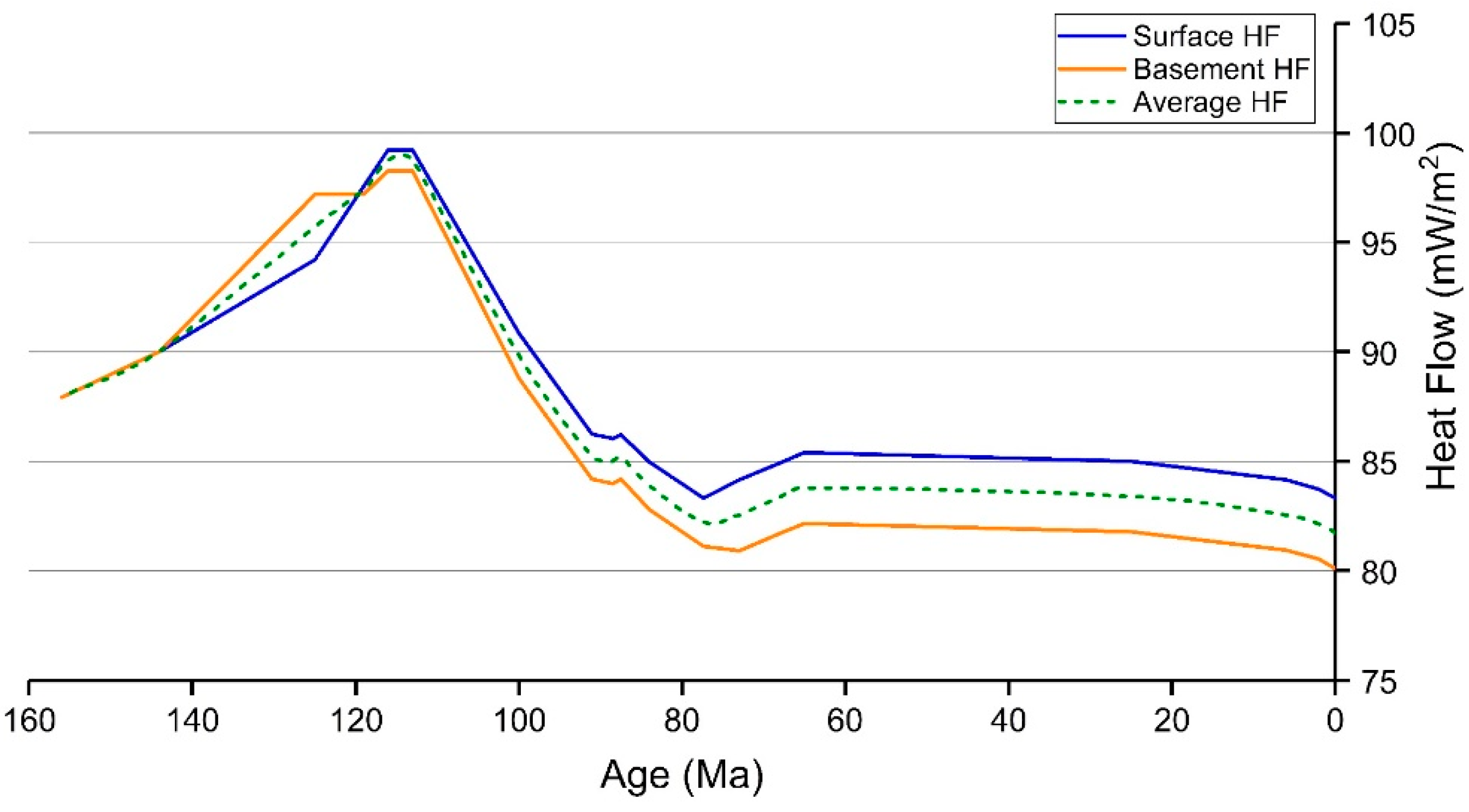

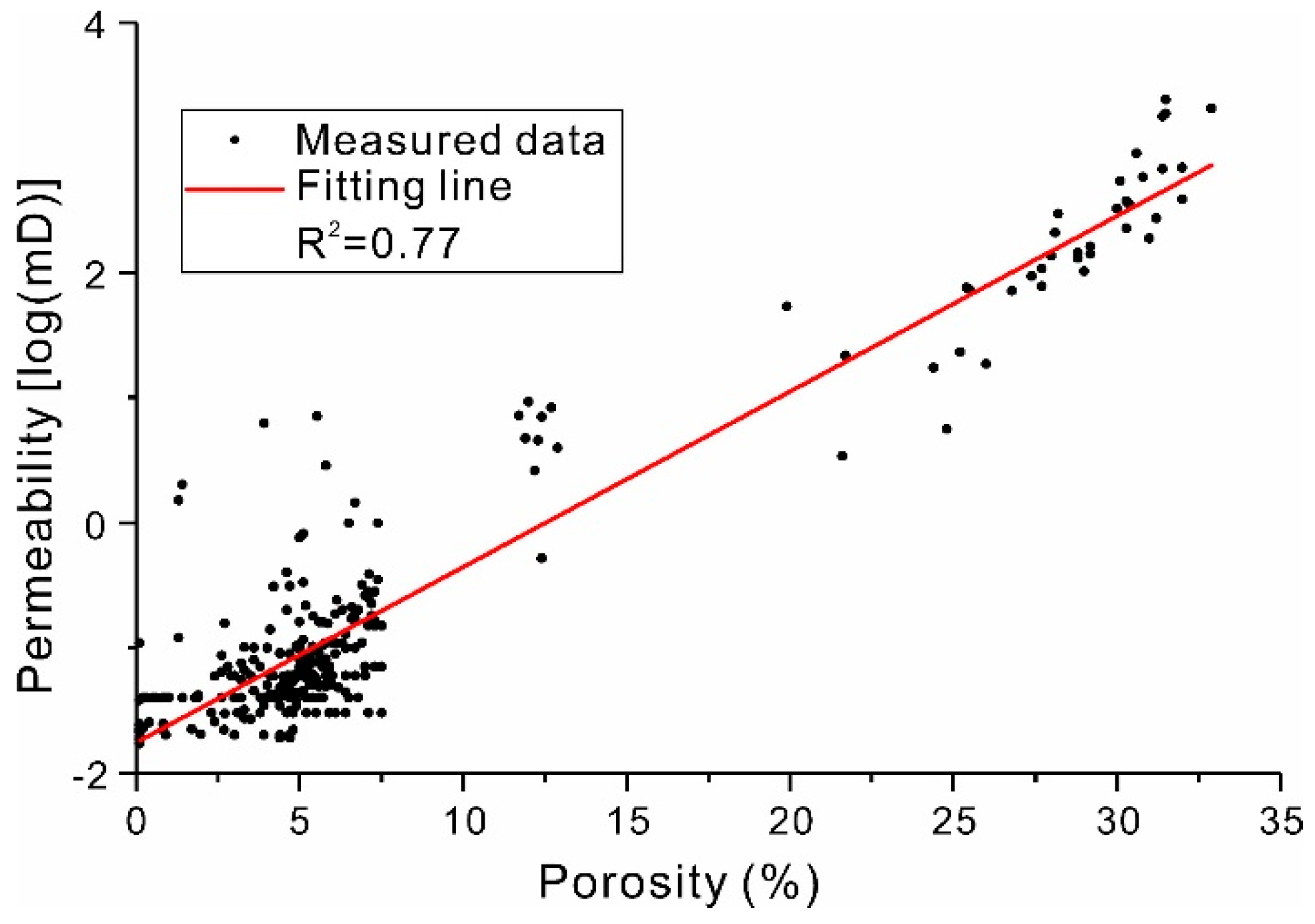

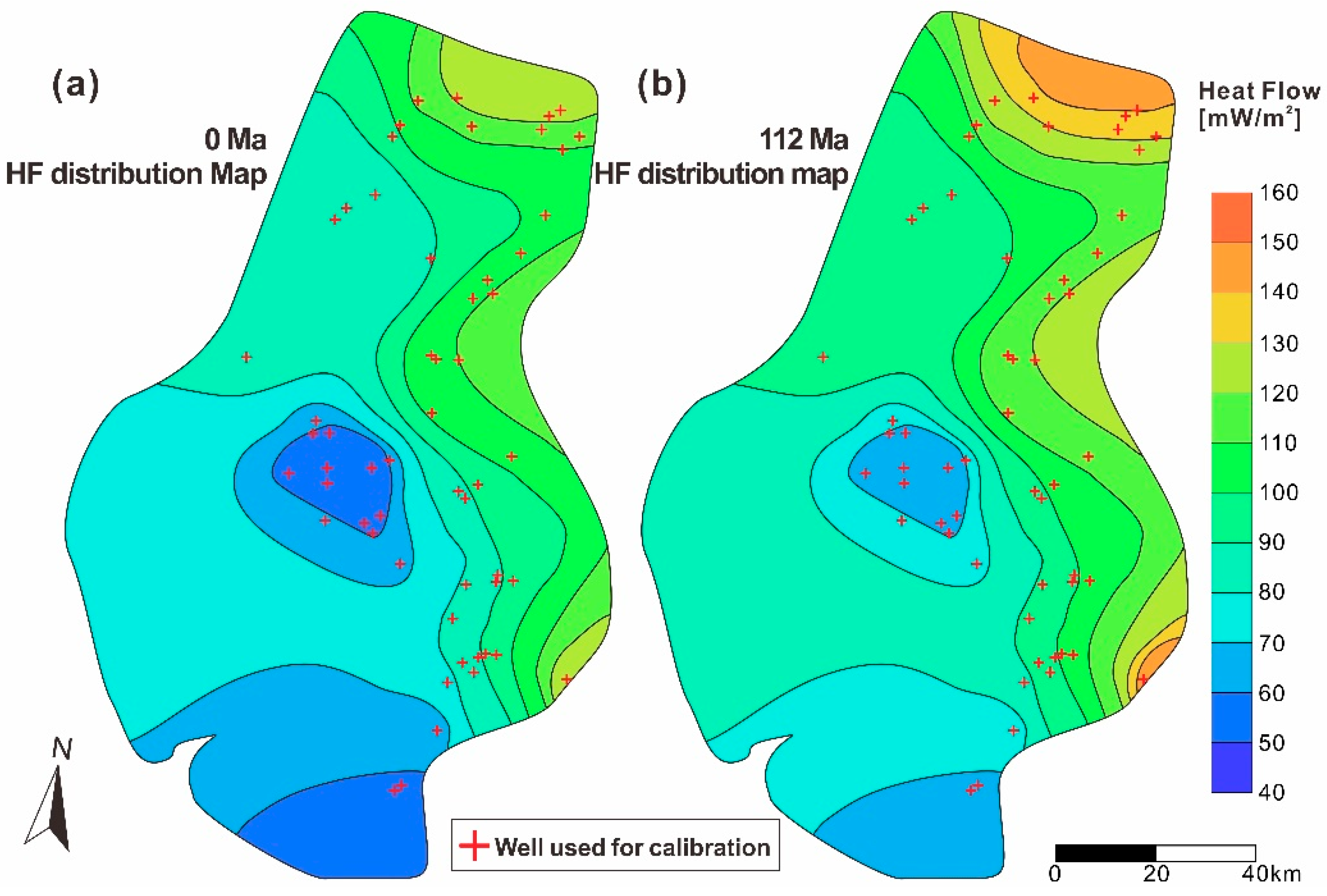
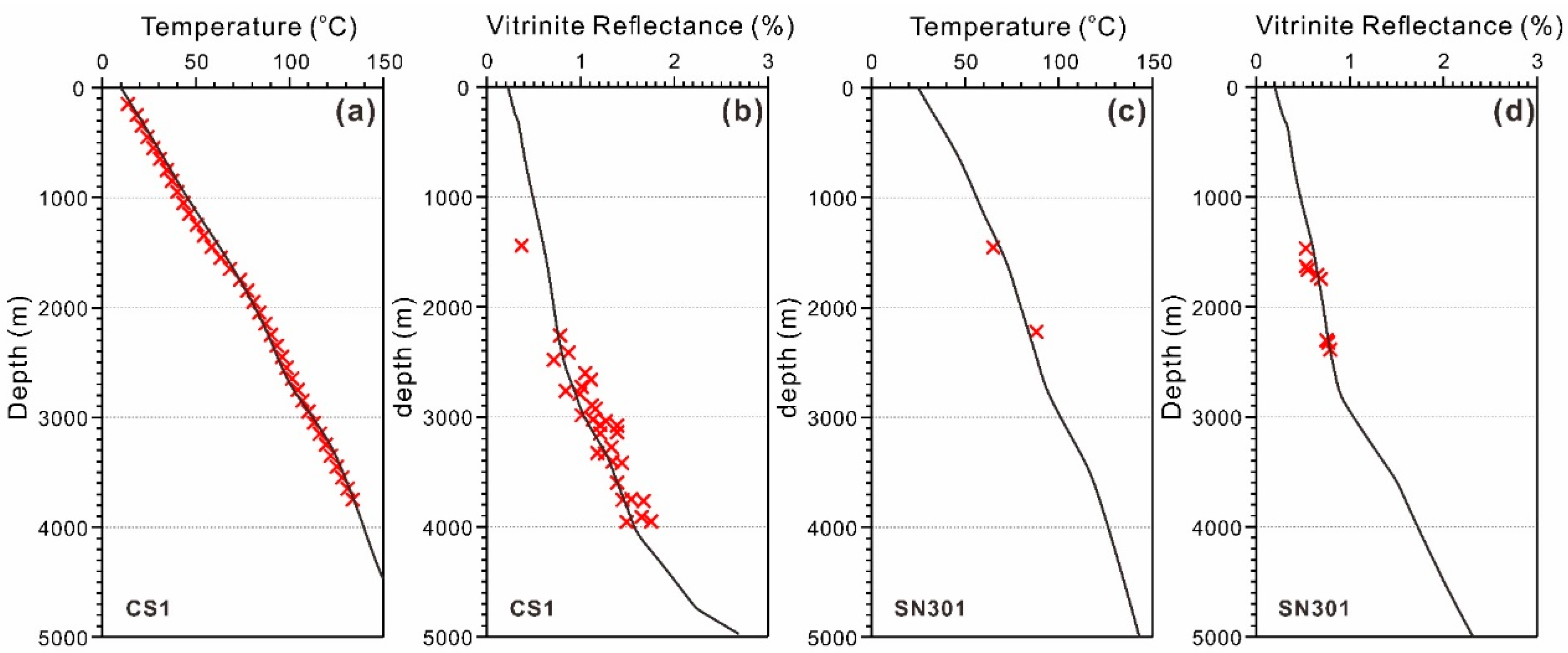



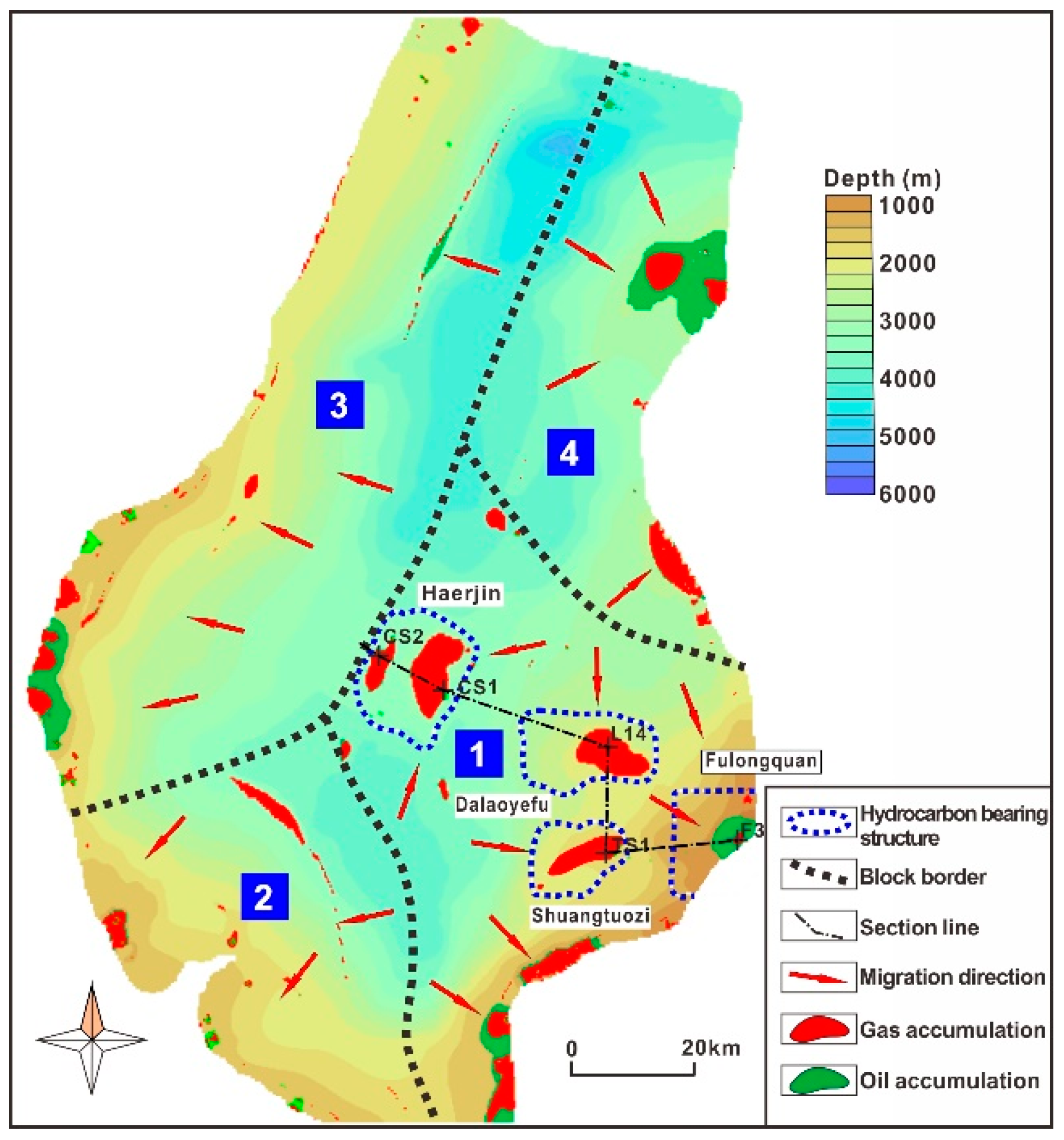
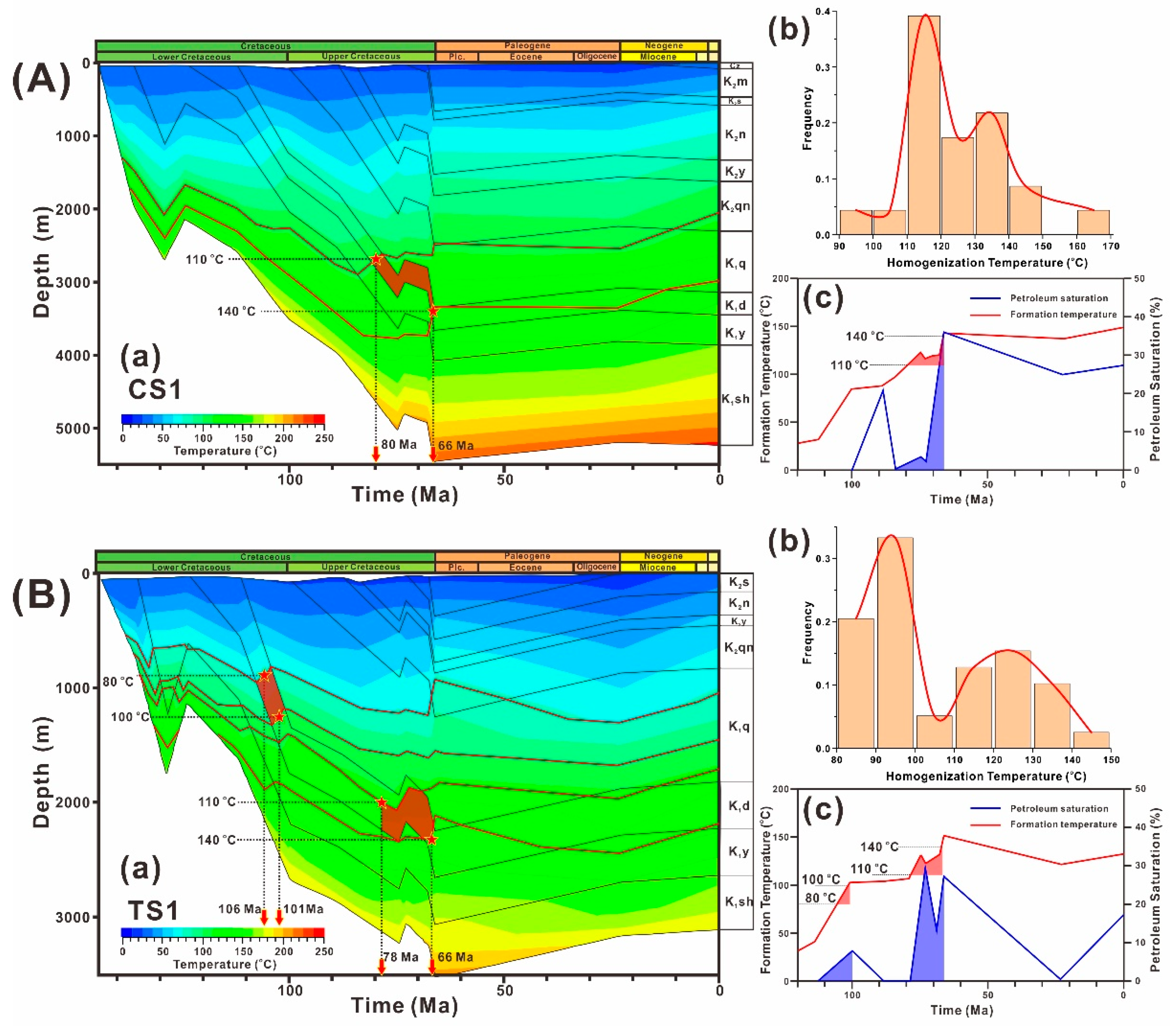

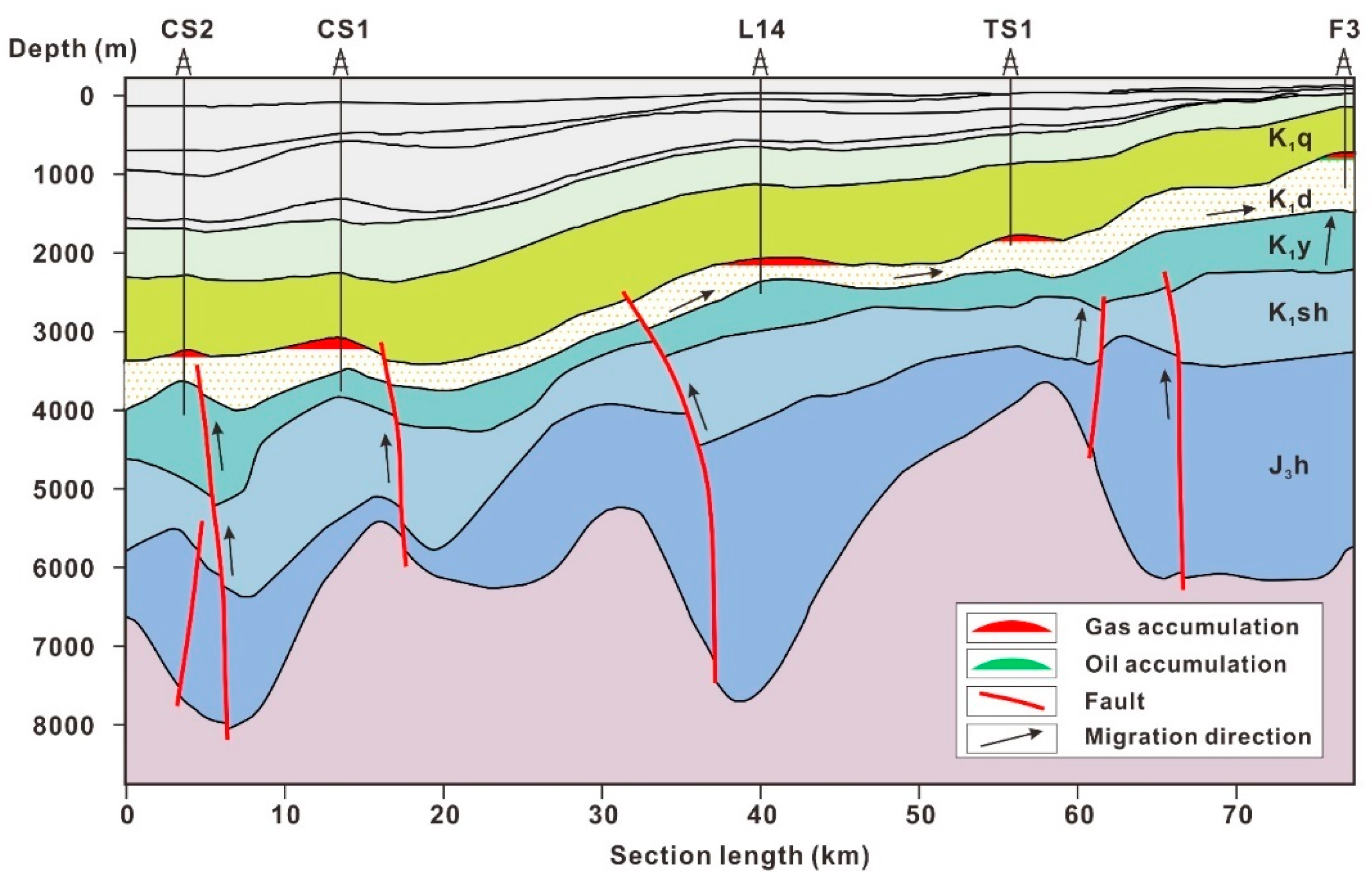
| Age | Formation | PSE | Lithology | Thermal Conductivity (W/m/K) | Radiogenic Heat | Heat Capacity (kcal/kg/K) | Mechanical properties | Athy’s Factor | |||||
|---|---|---|---|---|---|---|---|---|---|---|---|---|---|
| (Ma) | At 20 °C | At 100 °C | Uranium (ppm) | Thorium (ppm) | Potassium (%) | At 20 °C | At 100 °C | Density (kg/m3) | Initial Porosity (%) | k | |||
| 23.03–0 | Cenozoic | OR | Siltstone | 2.05 | 1.99 | 2.00 | 5.00 | 1.00 | 0.22 | 0.25 | 2720 | 55 | 0.51 |
| 66.2–23.03 | Erosion | ||||||||||||
| 67.7–66.2 | Mingshui Fm. | OR | Siltstone | 2.05 | 1.99 | 2.00 | 5.00 | 1.00 | 0.22 | 0.25 | 2720 | 55 | 0.51 |
| 73–67.7 | Sifangtai Fm. | OR | Sandstone | 3.35 | 2.95 | 1.50 | 5.10 | 3.60 | 0.21 | 0.24 | 2760 | 40 | 0.32 |
| 74.6–73 | Erosion | ||||||||||||
| 84–74.6 | Nenjiang Fm. | OR | Siltstone | 2.01 | 1.96 | 2.00 | 5.00 | 1.00 | 0.21 | 0.26 | 2710 | 43 | 1.06 |
| 88.5–84 | Yaojia Fm. | OR | Sandstone | 3.35 | 2.95 | 1.50 | 5.10 | 3.60 | 0.21 | 0.24 | 2760 | 40 | 0.66 |
| 100–88.5 | Qingshankou Fm. | OR | Sandstone | 3.95 | 3.38 | 1.30 | 3.50 | 1.30 | 0.20 | 0.24 | 2720 | 35 | 0.65 |
| 112–100 | Quantou Fm. | RR | Sandstone | 3.95 | 3.38 | 1.30 | 3.50 | 1.30 | 0.20 | 0.24 | 2720 | 38 | 0.99 |
| Seal | Shale | 1.64 | 1.69 | 3.70 | 12.00 | 2.70 | 0.21 | 0.24 | 2700 | 70 | 0.83 | ||
| 124–112 | Denglouku Fm. | RR | Sandstone | 3.95 | 3.38 | 1.30 | 3.50 | 1.30 | 0.20 | 0.24 | 2593 | 39 | 0.96 |
| 128.8–124 | Erosion | ||||||||||||
| 136–128.8 | Yingcheng Fm. | SR | Shale | 1.64 | 1.69 | 3.70 | 12.00 | 2.70 | 0.21 | 0.24 | 2700 | 70 | 0.83 |
| RR | Sandstone | 3.95 | 3.38 | 1.30 | 3.50 | 1.30 | 0.20 | 0.24 | 2537 | 41 | 0.88 | ||
| - | Igneous rock mixture | 2.61 | 2.40 | 3.12 | 6.76 | 3.68 | 0.20 | 0.23 | 2637 | 50 | 0.29 | ||
| 144–136 | Shahezi Fm. | SR | Siltstone | 2.00 | 1.96 | 2.50 | 6.50 | 2.00 | 0.22 | 0.26 | 2600 | 40 | 0.82 |
| SR | Coal | 1.60 | 1.66 | 2.00 | 3.00 | 0.70 | 0.26 | 0.30 | 1600 | 68 | 0.4 | ||
| 156–144 | Huoshiling Fm. | SR | Siltstone | 2.01 | 1.96 | 2.00 | 5.00 | 1.00 | 0.23 | 0.26 | 2710 | 55 | 0.51 |
| UR | Conglomerate | 2.30 | 2.18 | 1.50 | 4.00 | 2.00 | 0.20 | 0.23 | 2700 | 30 | 0.3 | ||
| Time | CS1 | CS107 | LS1 | TS5 | CS8 | CS12 | TS6 | F10 |
|---|---|---|---|---|---|---|---|---|
| End of Yingcheng Fm. | 420 | 390 | 450 | 425 | 373 | 348 | 460 | 410 |
| End of Nenjiang Fm. | 200 | 210 | 205 | 185 | 185 | 249 | 205 | / |
| End of Mingshui Fm. | 230 | 250 | 370 | 285 | 250 | 330 | 370 | 520 |
| Formation | Initial Porosity (%) | Rock Density (kg/m3) | Min porosity (%) | Factor k (1/km) |
|---|---|---|---|---|
| Denglouku | 39 | 2593 | 0.3 | 0.96 |
| Yingcheng | 41 | 2537 | 0.3 | 0.88 |
| Shahezi | 40 | 2600 | 0.3 | 0.82 |
© 2019 by the authors. Licensee MDPI, Basel, Switzerland. This article is an open access article distributed under the terms and conditions of the Creative Commons Attribution (CC BY) license (http://creativecommons.org/licenses/by/4.0/).
Share and Cite
Zhang, J.; Guo, J.; Li, Y.; Sun, Z. 3D-Basin Modeling of the Changling Depression, NE China: Exploring Petroleum Evolution in Deep Tight Sandstone Reservoirs. Energies 2019, 12, 1043. https://doi.org/10.3390/en12061043
Zhang J, Guo J, Li Y, Sun Z. 3D-Basin Modeling of the Changling Depression, NE China: Exploring Petroleum Evolution in Deep Tight Sandstone Reservoirs. Energies. 2019; 12(6):1043. https://doi.org/10.3390/en12061043
Chicago/Turabian StyleZhang, Jinliang, Jiaqi Guo, Yang Li, and Zhongqiang Sun. 2019. "3D-Basin Modeling of the Changling Depression, NE China: Exploring Petroleum Evolution in Deep Tight Sandstone Reservoirs" Energies 12, no. 6: 1043. https://doi.org/10.3390/en12061043





